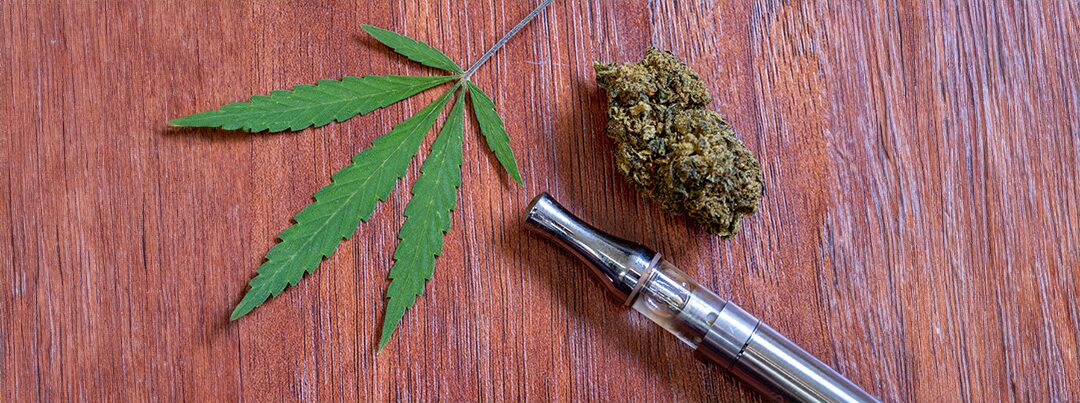No, we’re not talking about a fancy new ink that gets you high as you write. A weed pen, also known as a vapor pen or cannabis vaporizer, is the device used in marijuana vaping.
One of the newer ways of partaking in marijuana, vaping is on the rise. In 2024, according to data from Headset, vapor pens ranked as the second largest category of weed delivery methods in the U.S. It’s a multi-billion dollar industry and one that shows no signs of slowing down.
Whether you’re an old hand at vaping or ready to start shopping for your first weed pen, we’ve got the deets you need:
- A brief history of the weed pen
- How weed pens work
- Anatomy of a weed pen
- Benefits and cautions
A Brief History of the Weed Pen
The path that led to the modern vape pen is marked by a few major innovations. First, in 1903, French pharmacist Henry Ferre presented a prototype for an inhaler that released vapor from a chemical reaction. Next came the electric vaporizer, invented in 1927 by Joseph Robinson to hold medical compounds. Then, in the 1960s, Herbert Gilbert quit smoking cold turkey and patented a smokeless, non-tobacco cigarette to help others ease off tobacco.
But it was Chinese pharmacist Hon Lik who hit upon the device that is considered the direct predecessor of our modern weed pens — and it came to him in a dream 100 years after Ferre’s vaporizer design was released.
The longtime smoker wanted to make a change after his father was diagnosed with lung cancer. He dreamed he was submerged in water when suddenly the water turned to vapor, and he could breathe. His patented device — an electronic pen that could vaporize nicotine — hit the U.S. market in 2007.
As cannabis laws continually evolve in the U.S., vape pens have morphed into a way to ingest marijuana concentrate, not just nicotine.
How Weed Pens Work
The concept is pretty similar to Lik’s original design. Most vapes come in the form of a small tube, similar in look and size to a cigarette. Some are flattened, and others have a widened mouthpiece. In general, they are small, discrete and can be downright attractive.
Disposable vs. Reusable Weed Pens
Weed pens come in a wide range of sizes, shapes and brands. Broadly, they can be sorted into two categories.
| Pros | Cons | ||
| Disposable | Pre-charged and filled with cannabis concentrate. Designed to be thrown away after the cartridge is empty. | Cheaper up-front costConvenientNo refilling | More wasteFewer customization options |
| Reusable | Rechargeable battery and replaceable cartridge. | Cost-effective in the long runLess wasteMore features, like adjustable temperature and voltage | Require basic maintenance Require refilling |
Anatomy of a Weed Pen
Both disposable and refillable weed pens have the same basic anatomy.
Battery. Starting on the butt end is the battery, which is your pen’s power source. In reusable pens, the lithium-ion battery is rechargeable.
Atomizer. This is the heating element that warms the cannabis concentrate to produce vapor. It sits between the battery and the cartridge and converts the battery power into heat, which vaporizes the cannabis concentrate. It’s typically made from ceramic or quartz.
Cartridge. The cartridge holds the cannabis in concentrate or dry herb form. This is the weed portion of the weed pen. Cartridges (or carts) come in a wide range of consistencies, potency levels and even flavors.
Mouthpiece. The final element is the end of the weed pen, where you inhale the vapor. Some pens have a more pronounced mouthpiece, while others just blend into the streamlined pen body.
Benefits of a Weed Pen
Weed pens have a number of benefits over rolling a joint, which explains their massive rise in popularity in recent years:
- Discreet. Weed pens are a great way to take low-profile drags anywhere cannabis vaping is allowed. There is also little to no smell, making them easier to use in public settings.
- Portable. Weed pens are designed for portability. They are slim and fit comfortably in pockets or small bags.
- Easy to use. Weed pens are user-friendly and require very little prep work, especially if you opt for disposable options. There is no need to roll papers or mess with lighters.
Vape Health and Safety
Long-term health benefits and risks of vaping cannabis oil are still very much in the research phase, but we do know vaping can eliminate exposure to carbon monoxide and some carcinogenic byproducts of a traditional joint. One study found that vaporizer users were 40% less likely to report respiratory effects like cough, phlegm, and chest tightness than users who smoked cannabis.
To ensure the safest vape, purchase pens and cartridges from reputable companies. The good news for Oregonians is that the Oregon Liquor and Cannabis Commission (OLCC) has established some of the nation’s strictest guidelines around the making and selling of weed pens and cartridges. In 2020, the OLCC banned additives in cannabis vaping products, ensuring vape cartridges cannot contain artificially derived cannabinoids.
Talk with your favorite budtender to learn more about vaping safely and how to select the best product for you.

